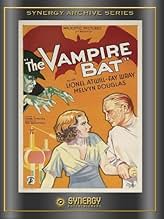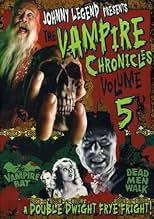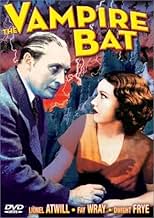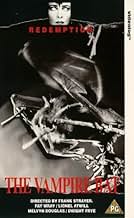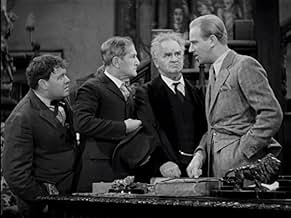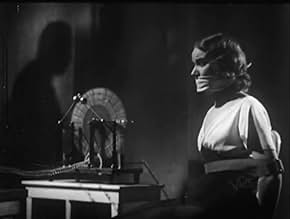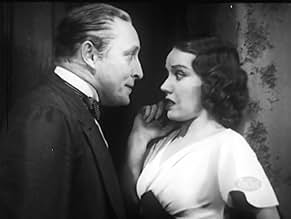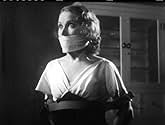NOTE IMDb
5,8/10
3,3 k
MA NOTE
Lorsque des cadavres vidés de leur sang commencent à apparaître dans un village européen, le vampirisme est soupçonné d'en être responsable.Lorsque des cadavres vidés de leur sang commencent à apparaître dans un village européen, le vampirisme est soupçonné d'en être responsable.Lorsque des cadavres vidés de leur sang commencent à apparaître dans un village européen, le vampirisme est soupçonné d'en être responsable.
- Réalisation
- Scénario
- Casting principal
Rita Carlyle
- Martha Mueller
- (as Rita Carlisle)
Ted Billings
- Townsman
- (non crédité)
Fern Emmett
- Gertrude
- (non crédité)
William Humphrey
- Dr. Haupt
- (non crédité)
Paul Panzer
- Townsman
- (non crédité)
Carl Stockdale
- Schmidt - Morgue Keeper
- (non crédité)
Paul Weigel
- Dr. Holdstadt
- (non crédité)
Avis à la une
In the small village of Kleinshloss, the locals are scared with a serial killer that is draining the blood of his victims, and the Burgomaster Gustave Schoen (Lionel Belmore) is convinced that a vampire is responsible for the deaths. The skeptical police inspector Karl Brettschneider (Melvyn Douglas) is reluctant to accept the existence of vampires, but the local doctor Otto Von Newman (Lionel Atwill) shows literature about cases of vampirism inclusive in Amazon. When the apple street vendor Martha Mueller (Rita Carlisle) is murdered, the prime suspect becomes the slow Herman Gleib (Dwight Frye), a man with a mind of child that loves bats. The group of vigilantes chases Herman, while Dr. Von Newman's housemaid Georgiana (Stella Adams) is attacked by the killer.
"The Vampire Bat" is an entertaining low-budget horror movie from the 30's that is visibly inspired in the success of Universal "Dracula" and "Frankenstein" in 1931. There are many analogies in the stories, like the living growing tissue or the innocence of Herman or the raged crowd. The characters are not well developed, and I did not understand the relationship of Ruth Bertin and her annoying hypochondriac aunt Gussie Schnappmann with Dr. Otto Von Newman, or how the doctor hypnotizes or controls his assistant Emile. It is great to see Fay Wray acting in the same year of "Mystery of the Wax Museum" and "King Kong". My vote is six.
Title (Brazil): "O Morcego Vampiro" ("The Vampire Bat")
"The Vampire Bat" is an entertaining low-budget horror movie from the 30's that is visibly inspired in the success of Universal "Dracula" and "Frankenstein" in 1931. There are many analogies in the stories, like the living growing tissue or the innocence of Herman or the raged crowd. The characters are not well developed, and I did not understand the relationship of Ruth Bertin and her annoying hypochondriac aunt Gussie Schnappmann with Dr. Otto Von Newman, or how the doctor hypnotizes or controls his assistant Emile. It is great to see Fay Wray acting in the same year of "Mystery of the Wax Museum" and "King Kong". My vote is six.
Title (Brazil): "O Morcego Vampiro" ("The Vampire Bat")
"The Vampire Bat" starts out fabulously, with eerie images of large bats fluttering through the dark night and a very atmospheric portrayal of a petrified little town with its superstitious inhabitants under the spell of a serial killer who seemly drains all the blood out of his/her victims' bodies. The opening sequences of this film (the first 15 minutes or so) is pure vintage horror, with a suspenseful introduction to the story (extended speeches with a detailed description of the killer's modus operandi) and a great use of set pieces and interiors that already proved their effectiveness earlier (the same scenery was used in Universal classics, like "The Old Dark House" for example). Very regrettable, however, is that the story quickly becomes tedious and predictable and the only element left to admire near the end is the sublime acting by a multi-talented cast. In the remote town of Kleinschloss (very cool name, by the way), they keep on finding bodies with not a single drop of blood left in them. The scared and superstitious villagers are convinced that there's a vampire in their midst (it wouldn't be the first time, according to the history books) and the prime suspect is the village-idiot, Hermann, who shows a bizarre affection towards bats. The only straight-thinking authority figure is inspector Karl Brettschneider, but even he can't come up with a rational explanation for the murders. If you're somewhat familiar with the roles and careers of eminent horror actors in the 30's, you know who the real culprit is right away and even if you're not it's not hard to guess, since the clues are numberless. "The Vampire Bat" isn't a very efficient whodunit mystery, but it definitely remains a must for fans of classic horror films since it brings together names like Fay Wray (immortal for her role in "King Kong"), Lionel Atwill ("Mystery of the Wax Museum"), Melvyn Douglas (Polanski's "The Tenant") and Dwight Fry. This latter is my personal favorite cast member here, mainly because he's a very underrated actor who always stood in the shadows of more important horror veterans. His performance of Herman the nut is truly terrific.
I take issue with the other reviewer's comments for the simple reason that this is a MYSTERY FILM, not a supernatural one! It is not the only film to have a seemingly "supernatural" explanation ("vampires"), but turns out to be a very mundance one.
Other films that come to mind are Edgar Wallace's "Before Dawn" and the (more famous) "Mark of the Vampire".
The film does a WONDERFUL job in creating a very "spooky atmosphere", similar DRACULA, when Renfield meets the Count on the staircase of his castle, or in MARK OF THE VAMPIRE, when the two people look thru the windows of the castle ruins and see a "corpse" playing an organ, while Luna descends using wings! VERY surreal!
If one likes these (often silent) atmospheric touches, THIS film is a MUST!
Norm Vogel
Other films that come to mind are Edgar Wallace's "Before Dawn" and the (more famous) "Mark of the Vampire".
The film does a WONDERFUL job in creating a very "spooky atmosphere", similar DRACULA, when Renfield meets the Count on the staircase of his castle, or in MARK OF THE VAMPIRE, when the two people look thru the windows of the castle ruins and see a "corpse" playing an organ, while Luna descends using wings! VERY surreal!
If one likes these (often silent) atmospheric touches, THIS film is a MUST!
Norm Vogel
Though not a horror film in the traditional sense, this creepy little film delivers the goods. It seems a vampire is loose in a small German town draining its victims of their blood. Police Inspector Karl Brettschneider, Melvyn Douglas in one of his early roles, is skeptical believing a crazed killer not a vampire is running amok. The only one who believes him is Ruth Bertin (Faye Wray) the inspector's girlfriend and lab assistant to Dr. Otto von Niemann (Lionel Atwill) who though apparently an eminent scientist goes along with the vampire theory. The townspeople suspect the weirdo Herman Gleib, played with his usual frenzy by Dwight Frye who seems to be having a lot of fun with his role. The film contains quite a bit of humor which helps relieve some of the intensity involved with all the murders being committed. One funny part has Gussie Schnappmann (Maude Eburne), Ruth Bertin's aunt, thinking weird Herman has turned not into a bat but into a dog. Maude Eburne and Dwight Frye make a good comedy team.
This budget movie brings in elements from "The Cabinet of Dr. Caligari" with Dr. Niemann using the power of suggestion to make a somnambulist carry out his orders, from "Frankenstein" by using the human blood to help create life in the laboratory, and "Dracula" since the murders are believed by everyone except the inspector and his girl to be the work of a bloodsucker. Thses elements are mixed well by director Frank R. Strayer with a little comedy thrown in for good measure. The concoction works. The restored version I viewed used tinting to increase the spooky atmosphere. So try to see the this version if possible.
This budget movie brings in elements from "The Cabinet of Dr. Caligari" with Dr. Niemann using the power of suggestion to make a somnambulist carry out his orders, from "Frankenstein" by using the human blood to help create life in the laboratory, and "Dracula" since the murders are believed by everyone except the inspector and his girl to be the work of a bloodsucker. Thses elements are mixed well by director Frank R. Strayer with a little comedy thrown in for good measure. The concoction works. The restored version I viewed used tinting to increase the spooky atmosphere. So try to see the this version if possible.
"The Vampire Bat" is one of those underrated horror films of the early 1930's that seems to impress more with each viewing. I won't go into the details of the plot, as that has been covered multiple times in other reviews, and it's not the story that makes the film shine.
There are three things that make "The Vampire Bat" stand out from the other poverty row films - the cast, the direction, and the comedy.
The Cast - Lionel Atwill, Melvyn Douglas, and Fay Wray get the heavy lifting in the film, and all are excellent. Atwill is perfect for this type of part, as he demonstrated many times. Douglas is sufficiently perplexed as the investigator, and Fay Wray is just gorgeous in distress. The other players add sufficiently, especially Dwight Frye channeling a dimmer version of Renfield from Dracula.
The Direction - Frank Strayer does an admirable job in shooting the film, with creepiness abundant and lots of camera movement. Some shots are just so outstanding (such as the opening scene), that they almost seem out of place in a cheap horror movie. Strayer provides loads of atmosphere and never loses the audience. An excellent job.
The Comedy - As with most horror films of this time, comedy relief was thrown in to lighten the mood of the audience, and in most films, the comedy was misplaced and terribly unfunny. However, in "The Vampire Bat" the comedy, mostly provided by Maude Eburne as Aunt Gussie, is spot on and still funny today. This helps to keep the film watchable.
The Downsides - There is really only a couple of downsides to the film. The first is the editing, which is clumsy and hurried. It sometimes spoils the excellent direction. Cuts are often not matched, and this can distract. Obviously, this was not a big budget film, so the sets and overall production values are not high, but this is mostly glossed over by the efficiency and care shown by the director, but there are a few scenes where the seams showed too much, like the cave scene, parts of which look like it was filmed in a closet.
Overall, "The Vampire Bat" is certainly worth a look for the great direction, a mad Lionel Atwill, and the always lovely Fay Wray.
There are three things that make "The Vampire Bat" stand out from the other poverty row films - the cast, the direction, and the comedy.
The Cast - Lionel Atwill, Melvyn Douglas, and Fay Wray get the heavy lifting in the film, and all are excellent. Atwill is perfect for this type of part, as he demonstrated many times. Douglas is sufficiently perplexed as the investigator, and Fay Wray is just gorgeous in distress. The other players add sufficiently, especially Dwight Frye channeling a dimmer version of Renfield from Dracula.
The Direction - Frank Strayer does an admirable job in shooting the film, with creepiness abundant and lots of camera movement. Some shots are just so outstanding (such as the opening scene), that they almost seem out of place in a cheap horror movie. Strayer provides loads of atmosphere and never loses the audience. An excellent job.
The Comedy - As with most horror films of this time, comedy relief was thrown in to lighten the mood of the audience, and in most films, the comedy was misplaced and terribly unfunny. However, in "The Vampire Bat" the comedy, mostly provided by Maude Eburne as Aunt Gussie, is spot on and still funny today. This helps to keep the film watchable.
The Downsides - There is really only a couple of downsides to the film. The first is the editing, which is clumsy and hurried. It sometimes spoils the excellent direction. Cuts are often not matched, and this can distract. Obviously, this was not a big budget film, so the sets and overall production values are not high, but this is mostly glossed over by the efficiency and care shown by the director, but there are a few scenes where the seams showed too much, like the cave scene, parts of which look like it was filmed in a closet.
Overall, "The Vampire Bat" is certainly worth a look for the great direction, a mad Lionel Atwill, and the always lovely Fay Wray.
Le saviez-vous
- AnecdotesTo keep production costs down, low-budget studio Majestic Pictures filmed at night on Universal's European village set, which was used for Frankenstein (1931). The interior of Lionel Atwill's house is the set from Une soirée étrange (1932).
- Gaffes[Spanish dubbed version] In the original version, when Herman encounters Aunt Gussie, he hides behind a bush and does a "meow" which draws Aunt Gussie to the bushes looking for the cat. In the Spanish dubbed version, they neglected to put in the "meow" so there is no motivation for Aunt Gussie to go to the bushes.
- Citations
Karl Brettschneider: I don't mind admitting that I'm up a tree. Stumped!
- Versions alternativesWhen originally released theatrically in the UK, the BBFC made cuts to secure a 'A' rating. All cuts were waived in 1993 when the film was granted a 'PG' certificate for home video.
- ConnexionsEdited into Haunted Hollywood: The Vampire Bat (2016)
Meilleurs choix
Connectez-vous pour évaluer et suivre la liste de favoris afin de recevoir des recommandations personnalisées
Détails
- Date de sortie
- Pays d’origine
- Langue
- Aussi connu sous le nom de
- Blood Sucker
- Lieux de tournage
- Société de production
- Voir plus de crédits d'entreprise sur IMDbPro
- Durée
- 1h 5min(65 min)
- Couleur
- Rapport de forme
- 1.37 : 1
Contribuer à cette page
Suggérer une modification ou ajouter du contenu manquant

